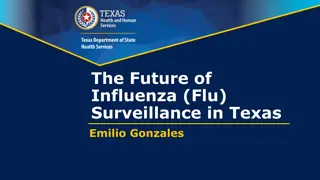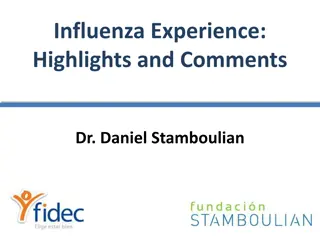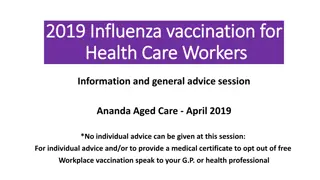Influenza A(H3N2)v at Jackson County Junior Fair 2022
Learn about an Influenza A(H3N2)v outbreak investigation at a fair. Understand the control steps taken and public health recommendations. Discover the partners involved and outbreak timeline details. Explore case definitions and surveillance methods. Popular
0 views • 14 slides
Impact of Highly Pathogenic Avian Influenza 2023 on South African Broiler Industry
The presentation by the South African Poultry Association sheds light on the detrimental effects of Highly Pathogenic Avian Influenza (HPAI) on the broiler industry in South Africa. Factors such as load shedding, water supply interruptions, and now, the outbreak of H7N6, have exacerbated the financi
4 views • 19 slides
Avian Influenza Overview and Outbreak History in South Africa
Avian Influenza, specifically Highly Pathogenic Avian Influenza (HPAI) outbreaks in South Africa, have been documented since 2004, affecting primarily ostriches and poultry. Wild bird transmission remains a concern, with risk factors such as rainfall, temperature, wetlands, and poultry movements con
2 views • 25 slides
United States Influenza Disease Burden by Season
Estimated influenza disease burden in the United States from the 2010-11 season through the 2022-23 season, including symptomatic illnesses, medical visits, hospitalizations, and deaths. The data provides insights into the impact of influenza over the years and preliminary estimates for the upcoming
8 views • 4 slides
Understanding Viral Diseases in Poultry: Newcastle Disease and Avian Influenza
Viral diseases like Newcastle Disease (ND) and Avian Influenza (AI) pose significant threats to poultry farming, impacting bird health and production. ND, caused by Avian paramyxovirus type 1, is highly contagious and manifests in various forms affecting birds' respiratory and nervous systems. On th
7 views • 24 slides
Asia-Pacific Livestock Diagnostics Market
Asia-Pacific Livestock Diagnostics Market by Product (Consumables {Swine Fever, Influenza}, System, Software), Technology (Immunodiagnostics {ELISA, LFA}, PCR), Animal Type (Swine, Bovine, Poultry), End User (POC, Veterinary Hospital) - Forecast to 2030
1 views • 4 slides
Update on Avian Influenza A(H5N1) Outbreak in the U.S.
Avian Influenza A(H5N1) has been detected in domestic livestock and a few human cases have been reported in the U.S. The CDC issued a technical report detailing the cases and their symptoms. No human-to-human transmission has been identified so far. The situation is being closely monitored and updat
0 views • 17 slides
Understanding Swine Erysipelas: Causes, Symptoms, and Prevention
Swine Erysipelas, caused by Erysipelothrix rhusiopathiae, is a significant disease in pigs, characterized by cutaneous erythema, diamond-shaped lesions, septicemia, and arthritis. The infection is primarily transmitted through contaminated feed, water, or skin abrasions. Clinical findings include su
0 views • 11 slides
Understanding Pandemic Influenza: Causes, Impacts, and Preparedness
Influenza pandemics have historically caused significant casualties, with the most notable being the 1918 H1N1 pandemic flu that resulted in approximately 50 million deaths. Understanding how diseases like the flu can cause a pandemic is crucial, including the groups most vulnerable and the necessar
1 views • 15 slides
Understanding Influenza: Key Concepts and Impact on Public Health
Influenza is a contagious respiratory illness caused by influenza viruses, with symptoms spread through droplets in the air or on surfaces. Vaccination and surveillance play vital roles in controlling flu outbreaks. Understanding the structure and types of influenza viruses, along with the importanc
0 views • 16 slides
Understanding Fetal Mummification in Domestic Animals
Failure in pregnancy stages can lead to fetal mummification, characterized by autolytic changes, mummification process, and dry, leathery tissue. Events required for mummification include fetal death post-bone development, rapid resorption of fluids, absence of oxygen and bacteria. This process is c
1 views • 27 slides
What is Influenza (Flu) in Children
Influenza, or the flu, is a contagious respiratory illness caused by influenza viruses. In children, it can lead to symptoms like fever, cough, sore throat, runny nose, and body aches. The flu can sometimes cause more severe complications, so it\u201
2 views • 8 slides
Swine Farming Basics and Uses of Different Pig Breeds
Explore the fundamentals of swine farming including vocabulary terms, historical milestones, and the wide range of products derived from pigs like pork chops, bacon, and even heart valves and insulin. Learn about popular pig breeds such as Yorkshire and Hampshire with their unique characteristics an
4 views • 23 slides
Understanding Orthomyxoviridae: Key Points on Influenza Viruses
Influenza viruses belong to the Orthomyxoviridae family and are major contributors to respiratory epidemics and pandemics. They consist of three genera - Influenza A, B, and C - with distinct morphological characteristics and genetic makeup. By exploring the properties, classification, and morpholog
0 views • 62 slides
Anemia in Swine: Causes, Clinical Signs, and Treatment
Anemia in swine can be caused by factors such as gastric ulcers, internal bleeding, and poor nutrition. Clinical signs include pale skin, rapid breathing, and jaundice. Piglet anemia, a highly fatal disease, is marked by decreased hemoglobin levels and liver degeneration. Diagnosis involves examinin
0 views • 11 slides
Protect Yourself and Others: Influenza Prevention Tips for Long-Term Care Facilities
Learn about the importance of influenza vaccination, common misconceptions, signs and symptoms of the flu, and preventive measures for both residents and staff in long-term care facilities. Stay informed and take proactive steps to safeguard against the flu virus.
0 views • 12 slides
Preventing Influenza at Long-Term Care Facilities: A Comprehensive Guide
Learn how to prevent influenza at long-term care facilities by promoting vaccination, practicing good hygiene, and recognizing flu symptoms. Visitors, residents, and staff all play crucial roles in safeguarding against the flu, which can have serious consequences, especially for vulnerable populatio
0 views • 12 slides
Preventing Influenza in Long-Term Care Facilities: Importance of Vaccination and Hygiene Practices
Influenza, commonly known as the flu, is a contagious respiratory illness that can have severe consequences, especially for vulnerable populations like those in long-term care facilities. This post emphasizes the importance of flu vaccination for residents, staff, and visitors, along with good hygie
0 views • 12 slides
Swine Euthanasia Guidelines and Methods
Explore detailed guidelines and methods for swine euthanasia, including mass depopulation strategies and humane handling techniques. Learn about acceptable and conditionally acceptable methods, as well as adjunct measures in case primary euthanasia fails, all aimed at ensuring the humane treatment o
0 views • 23 slides
Understanding the Impact of African Swine Fever on China's Agriculture Sector
The outbreak of African Swine Fever (ASF) in China has had significant ramifications on the global protein industry. With mortality rates exceeding 95% and no vaccine available, the country has seen massive losses in its hog population, affecting pork supplies worldwide. Chinese authorities are taki
0 views • 13 slides
Comprehensive Analysis of Policies and Laws on Feral Swine Translocation
Research and analysis conducted to assess the statutes, regulations, and policies relating to the translocation of live feral swine across all 50 U.S. states. The study aimed to enhance uniformity and effectiveness by providing recommendations based on state wildlife agency responses, surveys, and l
0 views • 12 slides
Texas Influenza Surveillance Overview
In this overview, we delve into the details of influenza surveillance in Texas, covering various aspects such as flu testing, notifiable conditions, and the 2022-2023 flu season review. The information provided includes surveillance structures, reporting requirements, and the vital role of testing i
0 views • 17 slides
Understanding Avian Influenza: Symptoms, Diagnosis, and Prevention
Avian influenza, or bird flu, is a viral disease affecting birds' respiratory, digestive, and nervous systems. It presents in two forms - Highly Pathogenic Avian Influenza Virus (HPAIV) and Low Pathogenic Avian Influenza Virus (LPAIV). The virus has two important surface antigens, Hemagglutinin (H)
0 views • 7 slides
Swine Influenza Update: Symptoms, Diagnosis, and Prevention Measures
Swine flu, caused by H1N1 virus, presents with symptoms like fever, sore throat, and respiratory issues. It spreads through inhalation and contact. Early diagnosis is crucial for effective management. Individuals with flu-like symptoms and recent travel or contact history should be monitored. Unders
0 views • 59 slides
Understanding Mycoplasmosis in Swine
Mycoplasmosis in swine is caused by Mycoplasma species, with Mycoplasma hyopneumoniae as the most common. It leads to chronic bronchopneumonia and can suppress the immune system, allowing other bacteria to proliferate in the lungs. The disease is characterized by slow growth in culture, adhesion to
0 views • 48 slides
Influenza Vaccination Campaign 2016: Aim, Objectives, and Implementation
The Influenza Vaccination Campaign in 2016 aimed to mitigate the effects of influenza by reducing morbidity and mortality, limiting virus transmission, and easing the burden on the healthcare system. The campaign was managed by a National Coordination Steering Committee, with focus on priority group
0 views • 13 slides
Understanding Avian Influenza: Symptoms, Transmission, and Prevention
Avian influenza, commonly known as bird flu, is a contagious disease caused by flu viruses that primarily affect birds but can also spread to humans. Learn about the symptoms in humans, how the virus spreads, and preventive measures to stay safe. Stay informed and take necessary precautions to reduc
0 views • 15 slides
Epidemiology of African Swine Fever in Uganda: Insights and Challenges
African Swine Fever (ASF), caused by a large DNA virus, poses a significant threat to domestic pig populations in Uganda. Factors influencing its persistence include high mortality rates, absence of vaccines or treatments, and its endemic nature in Sub-Saharan Africa (SSA). Research aims to understa
0 views • 12 slides
Rapid Influenza Outbreak Detection in Long-Term Care Facilities
The research investigates the effectiveness of rapid diagnostics in detecting influenza outbreaks in long-term care facilities. A non-blinded, randomized controlled trial in Wisconsin LTCFs showed that the intervention led to higher oseltamivir prophylaxis use, decreased ED visits, hospitalizations,
0 views • 6 slides
Understanding Equine Influenza: An Overview of Respiratory Tract Infections in Horses
Equine influenza is a contagious upper respiratory infection in horses caused by influenza viruses. This article covers the anatomy of the equine respiratory tract, signs, diagnosis, treatment, prevention, and prognosis of equine influenza. It also discusses the histological structure of the respira
0 views • 18 slides
Vaccination Status and Influenza Infection Among Pregnant Japanese Women
This study explores the impact of seasonal influenza vaccination on infection rates among pregnant Japanese women, focusing on primiparous and multiparous individuals. It discusses the background of influenza-related complications in pregnant women, presenting data on maternal mortality during the H
0 views • 30 slides
Epidemiology Update on Influenza Surveillance and Activity in Virginia
Providing insights into the influenza season in Virginia, this update highlights the importance of conducting surveillance, data sources for monitoring influenza-like illness, and comparisons of influenza activity levels over multiple seasons. By tracking influenza viruses and their impact, the goal
0 views • 47 slides
Understanding Swine EPDs for Effective Selection
Swine Expected Progeny Differences (EPDs) play a crucial role in selecting breeding stock by predicting various performance traits. This guide covers the definition of EPDs, their significance in selection, and specific EPDs like Number Born Alive, Days to 250 Pounds, and more. Learn about indices l
0 views • 12 slides
Application of Indirect and Avidity ELISAs for Anti-FMDV Antibody Assessment in Buffalo and Swine Serum Samples
In this study, researchers utilized indirect and avidity ELISAs to evaluate anti-foot-and-mouth disease virus (FMDV) antibodies induced by vaccination in serum samples from buffalo and swine in Argentina. The country is FMD-free, with vaccines applied to cattle and buffaloes but not to pigs. The res
0 views • 23 slides
New Requirements for PRRS & SECD Testing in Swine
The new rule mandates testing for Porcine Reproductive Respiratory Syndrome (PRRS) and Swine Enteric Corona Virus Disease (SECD) in swine moving into or within Wisconsin, with specific guidelines for testing, movement to exhibitions, and commercial farm scenarios. The rules also outline procedures f
0 views • 11 slides
Preventing Influenza at [Name of Critical Access Hospital]
Influenza, commonly known as the flu, is a contagious respiratory illness that affects millions annually, leading to hospitalizations and even deaths, particularly among older individuals. The 2016-2017 flu season alone saw staggering numbers of influenza cases and associated medical visits. Protect
0 views • 12 slides
Enhancing Influenza Surveillance in Texas: Strategies and Goals
Emilio Gonzales presents a comprehensive plan for advancing influenza surveillance in Texas, focusing on considerations, goals for the upcoming flu season, and strategies to increase participation in surveillance programs. The plan includes enhancing respiratory disease surveillance, expanding senti
0 views • 15 slides
Understanding Influenza: From Pandemics to Avian Flu Outbreaks
Influenza is a viral respiratory illness that can range from seasonal flu to pandemic outbreaks like the 2009 swine flu (H1N1) epidemic. The dangers and prevention methods of specific strains, such as H5N1 avian flu, have been witnessed since 2003. This summary delves into the characteristics, impac
0 views • 13 slides
Insights into Influenza: History, Pandemics, and Vaccines
Explore the impact of influenza through history, from the 1918 pandemic to current strains circulating. Learn about the disease burden, virus subtypes, and recommended vaccine composition. An overview of Dr. Daniel Stamboulian's contributions and disclosures is included, shedding light on the ongoin
0 views • 14 slides
Importance of 2019 Influenza Vaccination for Health Care Workers
Influenza, commonly known as the flu, is a contagious respiratory illness caused by influenza viruses that can spread through aerosols or surface contact. Common symptoms include fever, headache, fatigue, muscle pain, cough, and sore throat. The flu can be severe, leading to hospitalizations and eve
0 views • 19 slides


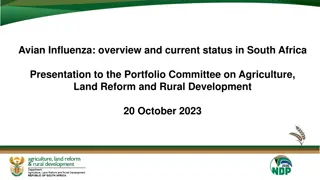
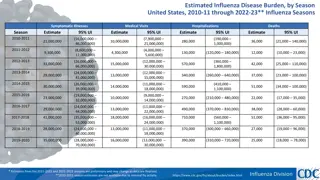
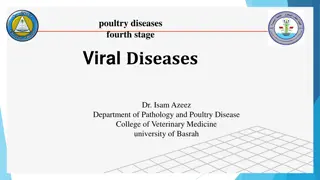


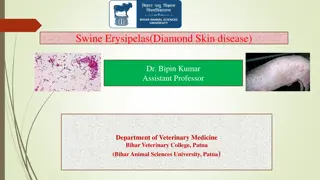

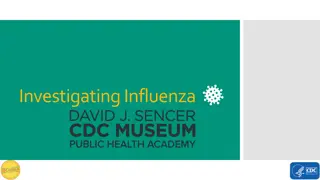
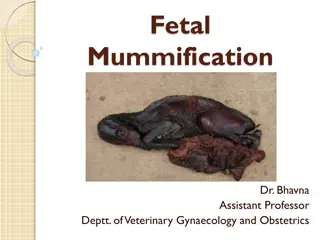
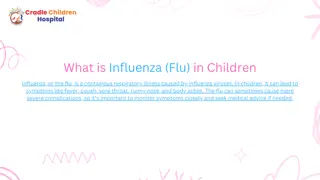


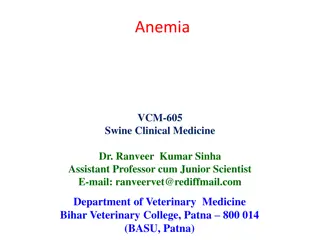
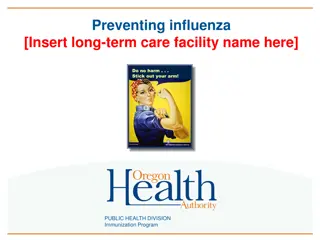

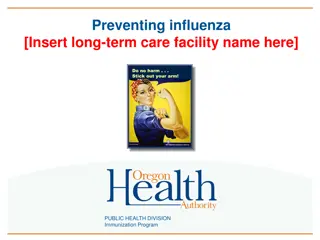
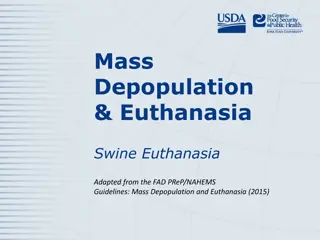

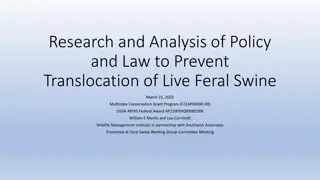


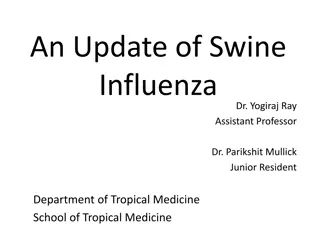
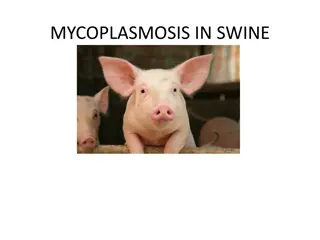
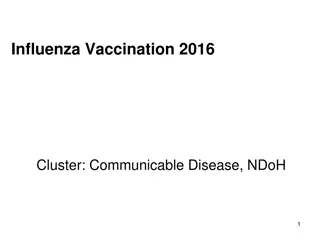
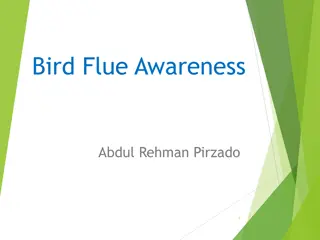
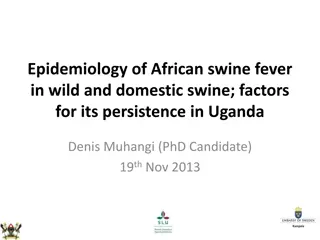
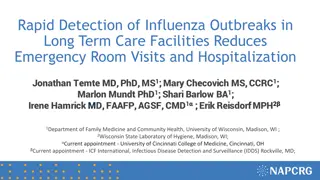

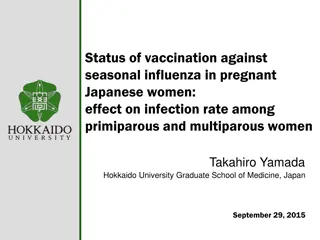
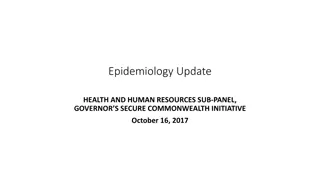

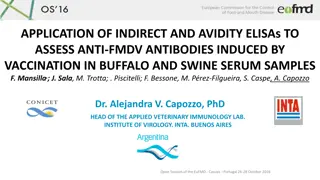
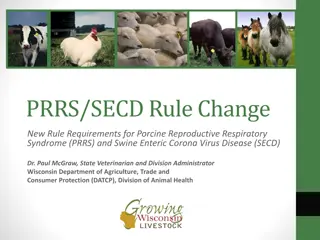
![Preventing Influenza at [Name of Critical Access Hospital]](/thumb/233818/preventing-influenza-at-name-of-critical-access-hospital.jpg)
